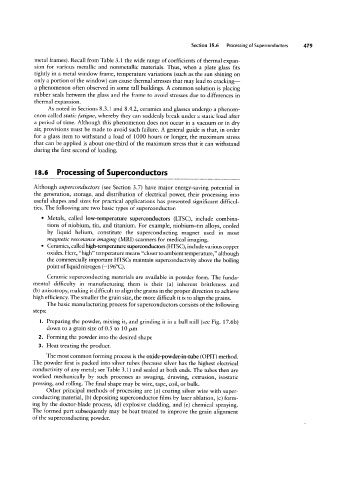Page 499 - 04. Subyek Engineering Materials - Manufacturing, Engineering and Technology SI 6th Edition - Serope Kalpakjian, Stephen Schmid (2009)
P. 499
Section 18.6 Processing of Superconductors
metal frames). Recall from Table 3.1 the wide range of coefficients of thermal expan-
sion for various metallic and nonmetallic materials. Thus, when a plate glass fits
tightly in a metal window frame, temperature variations (such as the sun shining on
only a portion of the window) can cause thermal stresses that may lead to cracking-
a phenomenon often observed in some tall buildings. A common solution is placing
rubber seals between the glass and the frame to avoid stresses due to differences in
thermal expansion.
As noted in Sections 8.3.1 and 8.4.2, ceramics and glasses undergo a phenom-
enon called static fatigue, whereby they can suddenly break under a static load after
a period of time. Although this phenomenon does not occur in a vacuum or in dry
air, provisions must be made to avoid such failure. A general guide is that, in order
for a glass item to withstand a load of 1000 hours or longer, the maximum stress
that can be applied is about one-third of the maximum stress that it can withstand
during the first second of loading.
l8.6 Processing of Superconductors
Although superconductors (see Section 3.7) have major energy-saving potential in
the generation, storage, and distribution of electrical power, their processing into
useful shapes and sizes for practical applications has presented significant difficul-
ties. The following are two basic types of superconductor:
° Metals, called low-temperature superconductors (LTSC), include combina-
tions of niobium, tin, and titanium. For example, niobium-tin alloys, cooled
by liquid helium, constitute the superconducting magnet used in most
magnetic resonance imaging (MRI) scanners for medical imaging.
° Ceramics, called high-temperature superconductors (HTSC), include various copper
oxides. Here, “high” temperature means “closer to ambient temperature,” although
the commercially important HTSCS maintain superconductivity above the boiling
point of liquid nitrogen (-196°C).
Ceramic superconducting materials are available in powder form. The funda-
mental difficulty in manufacturing them is their (a) inherent brittleness and
(b) anisotropy, making it difficult to align the grains in the proper direction to achieve
high efficiency. The smaller the grain size, the more difficult it is to align the grains.
The basic manufacturing process for superconductors consists of the following
steps:
I. Preparing the powder, mixing it, and grinding it in a ball mill (see Fig. 17.6b)
down to a grain size of 0.5 to 10 /zm
2. Forming the powder into the desired shape
3. Heat treating the product.
The most common forming process is the oxide-powder-in-tube (OPIT) method.
The powder first is packed into silver tubes (because silver has the highest electrical
conductivity of any metal; see Table 3.1) and sealed at both ends. The tubes then are
worked mechanically by such processes as swaging, drawing, extrusion, isostatic
pressing, and rolling. The final shape may be wire, tape, coil, or bulk.
Other principal methods of processing are (a) coating silver wire with super-
conducting material, (b) depositing superconductor films by laser ablation, (c) form-
ing by the doctor-blade process, (d) explosive cladding, and (e) chemical spraying.
The formed part subsequently may be heat treated to improve the grain alignment
of the superconducting powder.

